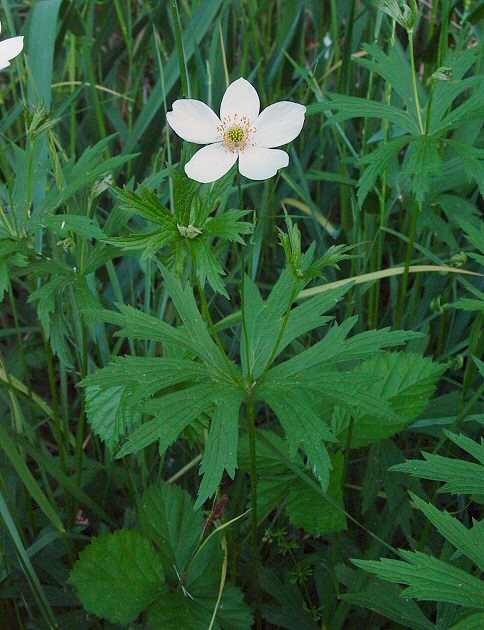Anemone canadensis L.
White Anemone

Native
CC = 6
CW = -3
MOC = 27
© DETenaglia
Anemone canadensis L.White Anemone | |
 |
Native CC = 6 CW = -3 MOC = 27 |
© DETenaglia |
|
Family - Ranunculaceae Habit - Rhizomatous perennial herb, sometimes branched.
Stems - Ascending to erect, to 55 cm, usually branched, silky-hairy.
Leaves - Basal leaves 1-7, deeply palmately divided into 3-5 lobes. Lobes divided again, toothed near apex, the ultimate leaf segments 5-16 mm wide, pointed at the tip, the margins toothed. Blades sericeous below, less so above, to 12 cm broad and long. Petioles to 15 cm long.
Inflorescence - Flowering stems bearing 1-3 involucres of opposite pairs or whorls of 3 leaflike bracts, these similar to leaf blades. Inflorescences solitary flowers or loose clusters of 1-5 flowers.
Flowers - Actinomorphic, perfect, stalked, the stalks hairy, to 9 cm. Petaloid sepals 5, white, glabrous, obovate to elliptic, to 2.4 cm long. Petals absent. Stamens numerous, the filaments glabrous. Anthers yellow. Pistils numerous, each with 1 style and 1 ovule.
Fruits - Head of fruits 5-10 mm long, 8-11 mm in diameter, nearly spherical. Achenes obovate in outline, pubescent with straight hairs not concealing the surface, the beak 3-6 mm long.
Flowering - May - July. Habitat - Levees, bottomland forests, bottomland prairies, bluff bases, flood plains, roadsides. Origin - Native to the U.S. Lookalikes - Broadly, A. virginiana, A. cylindrica. Other info. - This is a showy plant which sometimes forms large colonies. The large white flowers and palmate leaves provide for straightforward identification. When fresh, the petal-like sepals are brilliantly white, often faking camera light meters into underexposure. The plant is found in scattered locations in Missouri, predominantly in counties bordering the Missouri River. It U.S. range comprises two distinct regions - one across the upper Midwest and Northeast (with Missouri near the southern end of this region), the other along the Rocky Mountains southward into New Mexico. An odd but consistent habitat preference for this species is levee banks.
Photographs taken at the Squaw Creek National Wildlife Refuge, 5-3-00, and off the MKT Trail, Columbia, MO., 5-11-04 (DETenaglia); also on a levee near Augusta, Warren County, MO, 5-25-2008, 5-12-2014, and 5-14-2018; in Larimer County, CO, 7-31-2017, and at the Weldon Spring Site, St. Charles County, MO, 5-31-2020 (SRTurner). |